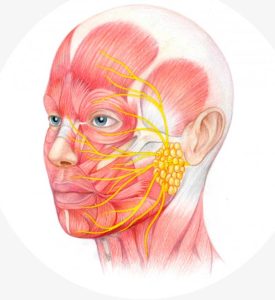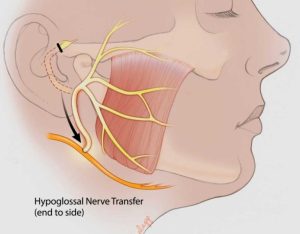
Facial paralysis
What is facial paralysis?
Tremors, weakness, or paralysis of the face can sometimes be a symptom of a disorder involving the facial nerve. This can be caused by various conditions such as Bell’s palsy, herpes zoster oticus, damage to the facial nerve, acoustic neuroma, facial nerve neurinoma, postoperative weakness of the facial nerve, mastoid infection, hemifacial spasm, and stroke.

Branches of the facial nerve extending towards the facial expression muscles.
An extensive evaluation may be required to determine the cause of this disorder and locate the areas of facial nerve involvement. Diagnostic investigation of the facial nerve may include auditory tests, x-rays, electronystagmography, electroneurography, and electromyography.
The most serious complication that can develop as a result of complete facial paralysis is a corneal ulcer of the eye, and it is therefore extremely important that the affected eye is protected. Protective eyewear should be worn outdoors to prevent dust particles from accumulating in the eye. If the eye is dry, eye drops may be needed. Such lubricants should be used when sleeping and, in cases of long-term paralysis, a procedure to facilitate eye closure may be necessary.

What treatments are there for facial paralysis?
The clinical treatment of facial paralysis aims to reduce swelling and can be performed until the nerve shows signs of recovery. Surgical treatment includes facial nerve decompression, facial nerve grafting, and facial resuscitation surgery. In some patients, if facial movement is partial and stable, it is possible to improve function with facial retraining.
At the Center for Neurotology and Acoustic Neurinoma (CNNA), our goal is to completely eliminate facial paralysis in patients. For very large tumors with existing facial paralysis, or in rare cases in which there is post-operative facial paralysis, we recommend a facial nerve resuscitation procedures in the first weeks after surgery to achieve satisfactory results.

